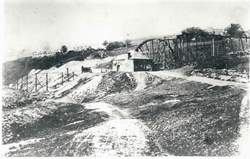Abandoned Communities ..... Dylife
Nevertheless, the price of lead and the very low level of wages made it difficult to run such an enterprise without making substantial profits. As well as lead the mines yielded significant quantities of copper, zinc, and silver. New shafts were dug, and machinery was brought in to assist with pumping, drawing, crushing ore, and separating the ore that contained substantial amounts of lead. Huge and magnificent waterwheels were installed to provide power to the machinery. The most spectacular among them was the Rhod Goch, or Red Wheel, erected in 1851. With a diameter of 63 feet and width of 3½ feet it was one of the largest waterwheels in Britain, possibly second only to the Lady Isabella on the Isle of Man.
Not quite all the power to the machinery was provided by waterwheels. In areas where ventilation was required it was supplied by a blowing machine operated by boys turning a handle.
One factor that very much reduced the profitability of the mines was the cost of transporting lead ore to smelters in Bristol, Chester, Liverpool, and elsewhere. The ore had to be taken 12 miles to the port of Derwenlas on the River Dyfi, where it would be loaded on to ships that would carry it around the coast to its destination. Local farmers were employed to transport the lead ore to Derwenlas on horse drawn carts. The route was rough and mountainous.
During the droving season the farmers' carts could expect to encounter herds of cattle and flocks of sheep coming in the opposite direction. The drovers would stay overnight at the Drop Inn at the western end of Dylife and have shoes put on the cattle at Rhyd y Porthmyn farm before continuing their journey through Mid Wales and into England.
The story of the drovers of Wales is wonderfully told by Fay Godwin and Shirley Toulson in The Drovers' Roads of Wales, Wildwood House, 1977. For information about the route past Dylife, and a map, go to pages 138-140.
By 1852 300 men, women, and children were employed at Dylife. The landowner, another Sir Watkin Williams-Wynn, was married that year, and on 28 April all employees were invited to a party to celebrate the wedding. According to an article in the Mining Journal they were supplied with tea, coffee, and cold meat. In spite of the absence of alcohol it was reported that "Plynlimon, that overlooked the scene, resounded with hilarity and song".
Mining Journal, 1 May 1852, p 107.
The events of the next few years are fully described in the article by CJ Williams, mentioned earlier. They were not happy times. Eventually it was agreed that the solution would be to sell the Dylife mines. A major part in the sale and the creation of a new company to administer the mines was played by Richard Cobden, an eminent politician well known to historians as the man who led the opposition to the Corn Laws. Cobden had married the youngest daughter of Hugh Williams. In partnership with another senior politician, John Bright, Cobden persuaded a group of Manchester businessmen to buy shares in the new company. The Dylife Mining Co. Ltd was registered on 7 July 1858, with John Bright as its chairman.
Not quite all the power to the machinery was provided by waterwheels. In areas where ventilation was required it was supplied by a blowing machine operated by boys turning a handle.
One factor that very much reduced the profitability of the mines was the cost of transporting lead ore to smelters in Bristol, Chester, Liverpool, and elsewhere. The ore had to be taken 12 miles to the port of Derwenlas on the River Dyfi, where it would be loaded on to ships that would carry it around the coast to its destination. Local farmers were employed to transport the lead ore to Derwenlas on horse drawn carts. The route was rough and mountainous.
During the droving season the farmers' carts could expect to encounter herds of cattle and flocks of sheep coming in the opposite direction. The drovers would stay overnight at the Drop Inn at the western end of Dylife and have shoes put on the cattle at Rhyd y Porthmyn farm before continuing their journey through Mid Wales and into England.
The story of the drovers of Wales is wonderfully told by Fay Godwin and Shirley Toulson in The Drovers' Roads of Wales, Wildwood House, 1977. For information about the route past Dylife, and a map, go to pages 138-
By 1852 300 men, women, and children were employed at Dylife. The landowner, another Sir Watkin Williams-
The events of the next few years are fully described in the article by CJ Williams, mentioned earlier. They were not happy times. Eventually it was agreed that the solution would be to sell the Dylife mines. A major part in the sale and the creation of a new company to administer the mines was played by Richard Cobden, an eminent politician well known to historians as the man who led the opposition to the Corn Laws. Cobden had married the youngest daughter of Hugh Williams. In partnership with another senior politician, John Bright, Cobden persuaded a group of Manchester businessmen to buy shares in the new company. The Dylife Mining Co. Ltd was registered on 7 July 1858, with John Bright as its chairman.
Two
The Rhod Goch (and a man)
The Rhod Goch, and the Rhanc-y-mynydd cottages in the distance
These two pictures have been kindly supplied by the curator of Llanidloes Museum

